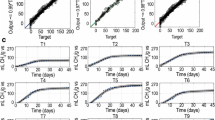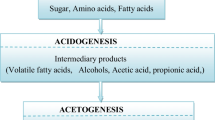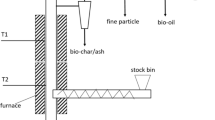Abstract
Biogas production from anaerobic co-digestion (ACoD) of palm oil mill effluent (POME) and cattle manure (CM) is getting a lot of attention due to its wide availability and relatively simple energy conversion technology. The ACoD process is extremely complex to model with conventional mathematical modeling methods and requires the use of advanced computational tools due to the mixing of different substrates. Artificial neural network (ANN) is a very recent alternative to modeling tools used to predict complex ACoD problems. To get the best performance from ANN, the parameters of ANN need to be optimized. Here, particle swarm optimization (PSO) algorithms can be a great option. The present study investigates the possibility of using the combined ANN-PSO framework to simulate the process and to predict biogas production from the ACoD of POME and CM. The mixture ratio of POME and CM, oxidation by hydrogen peroxide, and ammonium bicarbonate effects were analyzed separately to increase biogas production using solar-assisted bioreactors. From the experiment, five data volumes of the amounts of POME, CM, hydrogen peroxide, ammonium bicarbonate, and biogas yield were recorded. This dataset has been used to design the proposed model. The results of the proposed ANN-PSO framework with an understanding of mean square error (MSE) and correlation coefficient (R) are 0.0143 and 0.9923, respectively. This result indicates that the proposed method is found to be effective and flexible in predicting biogas production from the ACOD of POME and CM.








Similar content being viewed by others
References
Zaied BK, Siddique M, Zularisam A, Ahmad M, Salih Y (2019) Biomethane production from anaerobic codigestion of palm oil mill effluent with cattle manure: a review. Asian J Chem 31(11):2413–2424
Nasrullah M, Zularisam AW, Krishnan S, Sakinah M, Singh L, Fen YW (2019) High performance electrocoagulation process in treating palm oil mill effluent using high current intensity application. Chin J Chem Eng 27(1):208–217
Nasrullah M, Singh L, Mohamad Z, Norsita S, Krishnan S, Wahida N, Zularisam AW (2017) Treatment of palm oil mill effluent by electrocoagulation with presence of hydrogen peroxide as oxidizing agent and polialuminum chloride as coagulant-aid. Water Resources and Industry 17:7–10
Zaied BK, Nasrullah M, Siddique MNI, Zularisam AW, Singh L, Krishnan S (2019) Co-digestion of palm oil mill effluent for enhanced biogas production in a solar assisted bioreactor: Supplementation with ammonium bicarbonate, Sci. Total Environ. pp. 136095
Álvarez JA, Otero L, Lema JM (2010) A methodology for optimising feed composition for anaerobic co-digestion of agro-industrial wastes. Bioresour Technol 101(4):1153–1158
Zaied BK, Siddique MNI, Nasrullah M, Singh L, Wahid ZBA, Ahmad MF (2019) Application of solar assisted bioreactor for biogas production from palm oil mill effluent co-digested with cattle manure, Environmental Technology & Innovation, pp. 100446
Siddique M, Zaied BK, Krishnan S, Ahmad M (2019) Improving methane generation by co-digestion of sewage sludge and petrochemical wastewater: influence of heat and alkali pretreatment. Asian J Chem 31(10):2403–2409
Yi X, Wu R, Han D, Li Y, Li X, Niu G, Huang M, Ying G-G (2020) Adaptation of methane recovery, sludge characteristics and evolution of microbial community response to elevated nitrate under the methanogenic condition. J Clean Prod 258:120713
Hniman A, O-Thong S, Prasertsan P (2011) Developing a thermophilic hydrogen-producing microbial consortia from geothermal spring for efficient utilization of xylose and glucose mixed substrates and oil palm trunk hydrolysate. Int J Hydrog Energy 36(14):8785–8793
Poh PE, Chong MF (2009) Development of anaerobic digestion methods for palm oil mill effluent (POME) treatment. Bioresour Technol 100(1):1–9
Dobre P, Nicolae F, Matei FJRBL (2014) Main factors affecting biogas production-an overview, 19(3), pp. 9283–9296
Almomani F, Shawaqfah M, Bhosale RR, Kumar A, Khraisheh MAM (2017) Intermediate ozonation to enhance biogas production in batch and continuous systems using animal dung and agricultural waste. Int Biodeterior Biodegradation 119:176–187
Zaied BK, Nasrullah M, Siddique MNI, Zularisam A, Singh L, Krishnan S (2019) Enhanced bioenergy production from palm oil mill effluent by co-digestion in solar assisted bioreactor: effects of hydrogen peroxide pretreatment, Journal of Environmental Chemical Engineering, pp. 103551
Siedlecka E, Stepnowski P (2005) Phenols degradation by Fenton reaction in the presence of chlorides and sulfates, Polish Journal of Environmental Studies 14(6)
Siddique MNI, Sakinah M, Zularisam A (2014) Mesophilic and thermophilic biomethane production by co-digesting pretreated petrochemical wastewater with beef and dairy cattle manure. J Ind Eng Chem 20(1):331–337
Nair VV, Dhar H, Kumar S, Thalla AK, Mukherjee S, Wong JWC (2016) Artificial neural network based modeling to evaluate methane yield from biogas in a laboratory-scale anaerobic bioreactor. Bioresour Technol 217:90–99
Niu G, Yi X, Chen C, Li X, Han D, Yan B, Huang M, Ying G (2020) A novel effluent quality predicting model based on genetic-deep belief network algorithm for cleaner production in a full-scale paper-making wastewater treatment. J Clean Prod 265:121787
Liu H, Yang C, Huang M, Wang D, Yoo C (2018) Modeling of subway indoor air quality using Gaussian process regression. J Hazard Mater 359:266–273
Betiku E, Taiwo AE (2015) Modeling and optimization of bioethanol production from breadfruit starch hydrolyzate Vis-à-Vis response surface methodology and artificial neural network. Renew Energy 74:87–94
Shariati M, Mafipour MS, Mehrabi P, Bahadori A, Zandi Y, Salih MNA, Nguyen H, Dou J, Song X, Poi-Ngian S (2019) Application of a hybrid artificial neural network-particle swarm optimization (ANN-PSO) model in behavior prediction of channel shear connectors embedded in normal and high-strength concrete. Appl Sci 9(24):5534
Le LT, Nguyen H, Dou J, Zhou J (2019) A comparative study of PSO-ANN, GA-ANN, ICA-ANN, and ABC-ANN in estimating the heating load of buildings’ energy efficiency for smart city planning, 9(13), pp. 2630
Akbaş H, Bilgen B, Turhan AM (2015) An integrated prediction and optimization model of biogas production system at a wastewater treatment facility. Bioresour Technol 196:566–576
Vickers NJ (2017) Animal communication: when i’m calling you, will you answer too? Curr Biol 27(14):R713–R715
Tufaner F, Avşar Y, Gönüllü MT (2017) Modeling of biogas production from cattle manure with co-digestion of different organic wastes using an artificial neural network. Clean Techn Environ Policy 19(9):2255–2264
Beltramo T, Klocke M, Hitzmann B (2019) Prediction of the biogas production using GA and ACO input features selection method for ANN model. Information Processing in Agriculture 6(3):349–356
Jacob S, Banerjee R (2016) Modeling and optimization of anaerobic codigestion of potato waste and aquatic weed by response surface methodology and artificial neural network coupled genetic algorithm. Bioresour Technol 214:386–395
Beltramo T, Ranzan C, Hinrichs J, Hitzmann B (2016) Artificial neural network prediction of the biogas flow rate optimised with an ant colony algorithm. Biosyst Eng 143:68–78
Nguyen H, Moayedi H, Foong LK, Al Najjar HAH, Jusoh WAW, Rashid ASA, Jamali J (2019) Optimizing ANN models with PSO for predicting short building seismic response, Engineering with Computers
Chandrasekaran M, Tamang S (2017) ANN–PSO integrated optimization methodology for intelligent control of MMC machining. Journal of The Institution of Engineers (India): Series C 98(4):395–401
Lazzús JA (2013) Neural network-particle swarm modeling to predict thermal properties. Math Comput Model 57(9):2408–2418
Rasi S, Veijanen A, Rintala J (2007) Trace compounds of biogas from different biogas production plants. Energy 32(8):1375–1380
Ahmad AL, Ismail S, Ibrahim N, Bhatia S (2003) Removal of suspended solids and residual oil from palm oil mill effluent. J Chem Technol Biotechnol 78(9):971–978
Almomani F, Bhosale RR (2020) Enhancing the production of biogas through anaerobic co-digestion of agricultural waste and chemical pre-treatments. Chemosphere 255:126805
Zahra Azayite F, Achchab SJAPA (2019) A hybrid neural network model based on improved PSO and SA for bankruptcy prediction
Wang J, Niu T, Wang R (2017) Research and application of an air quality early warning system based on a modified least squares support vector machine and a cloud model. International Journal of Environmental Research Public Health Monograph 14(3):249
Kennedy J, Eberhart RC (1997) A discrete binary version of the particle swarm algorithm, 1997 IEEE International Conference on Systems, Man, and Cybernetics. Computational Cybernetics and Simulation, pp. 4104–4108 vol.5
Ye J, Hajirasouliha I, Becque J, Eslami A (2016) Optimum design of cold-formed steel beams using particle swarm optimisation method. J Constr Steel Res 122:80–93
Rice EW, Baird RB, Eaton AD, Clesceri LS, Standard methods for the examination of water and wastewater, American Public Health Association Washington, DC2012
Wang X, Lu X, Li F, Yang G (2014) Effects of temperature and carbon-nitrogen (C/N) ratio on the performance of anaerobic co-digestion of dairy manure, chicken manure and rice straw: focusing on ammonia inhibition. PLoS One 9(5):e97265
Ivana C, Maríaa T, Auraa V, Paolaa A, Marioc H (2016) Anaerobic co-digestion of organic residues from different productive sectors in Colombia: biomethanation potential assessment. Chem Eng 49:385–390
Veeken A, Kalyuzhnyi S, Scharff H, Hamelers B (2000) Effect of pH and VFA on hydrolysis of organic solid waste. J Environ Eng 126(12):1076–1081
Lee J, Park KY (2020) Impact of hydrothermal pretreatment on anaerobic digestion efficiency for lignocellulosic biomass: influence of pretreatment temperature on the formation of biomass-degrading byproducts. Chemosphere 256:127116
Siddique NI, Zularisam A (2012) Renewable methane from ammonium bicarbonate supplemented petrochemical wastewater treatment during anaerobic co-digestion in CSTR. Procedia Engineering 50:134–141
Ghatak MD, Ghatak A (2018) Artificial neural network model to predict behavior of biogas production curve from mixed lignocellulosic co-substrates. Fuel 232:178–189
Khalifa M, Emtir M (2009) Rigorous optimization of heat-integrated and Petlyuk column distillation configurations based on feed conditions. Clean Techn Environ Policy 11(1):107–113
Ozkaya B, Demir A, Bilgili MS (2007) Neural network prediction model for the methane fraction in biogas from field-scale landfill bioreactors. Environ Model Softw 22(6):815–822
Sahinkaya E, Özkaya B, Kaksonen AH, Puhakka JA (2007) Neural network prediction of thermophilic (65°C) sulfidogenic fluidized-bed reactor performance for the treatment of metal-containing wastewater, 97(4), 780–787
Abu Qdais H, Bani Hani K, Shatnawi N (2010) Modeling and optimization of biogas production from a waste digester using artificial neural network and genetic algorithm. Resour Conserv Recycl 54(6):359–363
Gueguim Kana EB, Oloke JK, Lateef A, Adesiyan MO (2012) Modeling and optimization of biogas production on saw dust and other co-substrates using artificial neural network and genetic algorithm. Renew Energy 46:276–281
Awais M, Alvarado-Morales M, Tsapekos P, Gulfraz M, Angelidaki I (2016) Methane production and kinetic modeling for co-digestion of manure with lignocellulosic residues. Energy Fuel 30(12):10516–10523
Deng Y, Qiu L, Shao Y, Yao Y (2019) Process modeling and optimizing of anaerobic co-digestion of peanut hull and swine manure using response surface methodology, Energy Fuels
Lebon E, Caillet H, Akinlabi E, Madyira D, Adelard L (2019) Kinetic study of anaerobic co-digestion, analysis and modelling. Procedia Manufacturing 35:321–326
Jaroenpoj S, Yu J, Ness J (2015) Development of artificial neural network models for biogas production from co-digestion of leachate and pineapple peel. Glob environ eng 1:42–47
Funding
We gratefully acknowledge the research grant from Ministry of Higher Education Malaysia: (FRGS/1/2019/TK07/UMP/02/5) through Universiti Malaysia Pahang (RDU1901202) for financially supporting this study.
Author information
Authors and Affiliations
Corresponding author
Additional information
Publisher’s Note
Springer Nature remains neutral with regard to jurisdictional claims in published maps and institutional affiliations.
Rights and permissions
About this article
Cite this article
Zaied, B.K., Rashid, M., Nasrullah, M. et al. Prediction and optimization of biogas production from POME co-digestion in solar bioreactor using artificial neural network coupled with particle swarm optimization (ANN-PSO). Biomass Conv. Bioref. 13, 73–88 (2023). https://doi.org/10.1007/s13399-020-01057-6
Received:
Revised:
Accepted:
Published:
Issue Date:
DOI: https://doi.org/10.1007/s13399-020-01057-6




